Despite the fact that some can be feisty, pine snakes have increased in popularity.
I remember well my first encounter with a wild pine snake. Coincidentally, it was also my first trip to the New Jersey Pine Barrens. It was early May, and I had traveled to the Pine Barrens with a friend, not specifically in search of pine snakes (a species which I had been very familiar with but just assumed was so uncommon that I would likely never see a wild specimen), but to finally explore one of the legendary hunting locales made famous by author Carl Kauffeld.
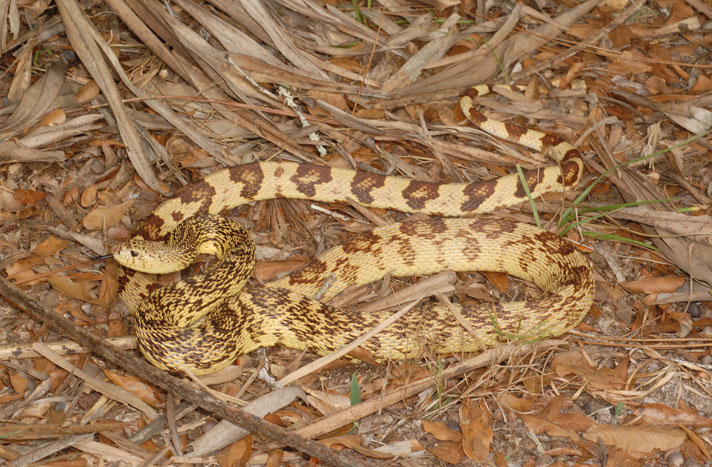
bill love
Louisiana pine snake (Pituophis melanoleucus ruthveni).
We started early, hiking through the endless miles of pine forests, just hoping to catch a glimpse of a corn snake (Pantherophis guttatus) at the northernmost tip of its range, or perhaps an eastern kingsnake (Lampropeltis getula getula) lying out in the open, absorbing some of the splintered sunlight.
After many long, unsuccessful hours of hiking in the dry heat and tick-infested forests, we headed for open ground. I encountered a meadow in which I discovered several spotted turtles (Clemmys guttata), and further along, an old set of railroad ties that were easily accessible as the rails had long since been removed. It was near these old railroad ties that the Pine Barrens of my imagination finally came to life!
Upon lifting the old timbers dotting the area, I encountered numerous eastern fence lizards (Sceloporus undulatus hyacinthinus), from hatchlings to adults, multiple eastern kingsnakes, eastern garter snakes (Thamnophis s. sirtalis), an eastern hognose snake (Heterodon platyrhinos), several southern ring-necked snakes (Diadophis p. punctatus) and even a northern water snake (Nerodia s. sipedon) that was well-removed from any kind of permanent water source.
As the sun sank in the sky, and after many long hours in the heat, completely exhausted from all of the walking and lifting, it was time to head home. As we made the journey back to the car, I noticed a random railroad tie buried two-thirds beneath the sand, with a fair amount of old plant growth and gravel above it. I braced myself firmly against the ground, and with every bit of strength I had left, I lifted and pushed the timber up while attempting to peer beneath. It was dark under there, and disturbing it created a huge cloud of dust and sand, but I could see something there. My first thought was northern black racer. With the timber now resting upon my left shoulder, I shot my free hand beneath and grabbed hold of my first Pituophis!
I was extremely shocked and amazed, as I didn’t actually expect to find anything beneath the heavy block of wood, let alone a 5½ -foot northern pine snake! Keeping with typical pine snake character, there was a lot of hissing, striking and all-around menacing behavior. My first guess was that this was a gravid female pulled from her nest, but as it turned out, the snake was actually an adult male that was deep into a shed cycle. We took many photographs, released the majestic beast and left the New Jersey Pine Barrens with a lifetime of priceless memories.
Pine Snake Taxonomy/Distribution
A rather large genus described by American scientist John Edwards Holbrook in 1842, Pituophis contains the pine snakes, of which there are three species and five subspecies. The common pine snakes (Pituophis melanoleucus) are composed of the northern pine snake (P. m. melanoleucus), the black pine snake (P. m. lodingi) and the Florida pine snake (P. m. mugitus), each of which resides in the southeastern United States in sometimes scattered but often heavy populations from the south New Jersey Pine Barrens westward to west Virginia and south to Florida and west to eastern Louisiana.
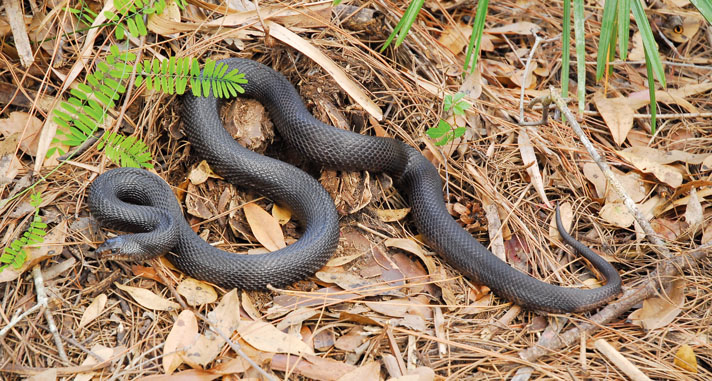
bill love
The black pine snake (Pituophis melanoleucus lodingi).
Pituophis also contains the Louisiana pine snake (P. ruthveni), an extremely rare snake from west-central Louisiana into east Texas, and lastly the Mexican pine snakes, of which there are two subspecies: the Mexican pine snake (P. d. deppei) and the northern Mexican pine snake (P. d. jani) from areas of western Sierra Madre and central Mexican highlands, north to central Nuevo Leon and regions west.
Joining the pine snakes in the genus Pituophis are the gopher snakes, of which there are two species and 13 subspecies, which include the bull snake, a subspecies of the gopher snake.
This article will focus on the pine snakes found in the United States that turn up with relative frequency in the hobby: P. m. melanoleucus, P.m. lodingi, P. m. mugitus and P. ruthveni.
Pine Snake Description/Natural History
With relatively small heads not much wider than their own necks and rough, keeled scales not unlike that of water snakes, pine snakes are among the largest of the non-venomous North American snakes. Adults of most species max out at a solid 5 to 8 feet in length.
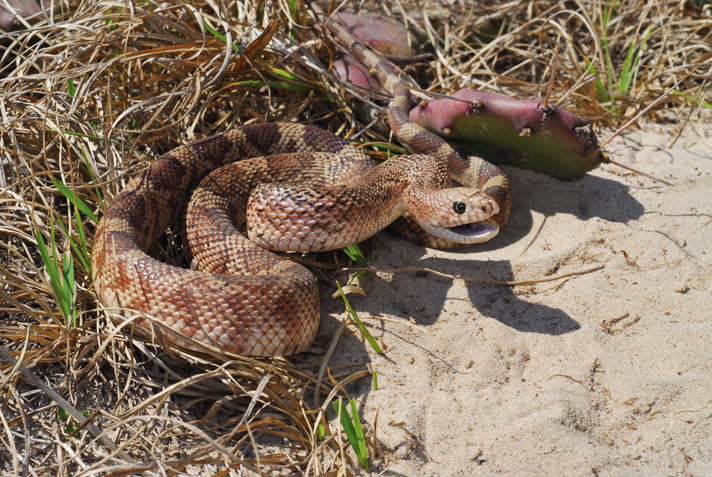
bill love
The Florida pine snake (Pituophis melanoleucus mugitus).
Although commonly encountered along the Coastal Plain in the sandy, loose soil of pine and mixed hardwood forests, in other parts of their range the pine snakes may be associated in less-dense populations with higher elevation habitats of nearly 9,000 feet above sea level. Most pine snakes are equipped with disruptive coloration that helps them to blend in well with their surroundings. The exception is P. m. lodingi, which loses the saddled pattern of the hatchlings and juveniles and progressively becomes uniform black, often ending up with no remaining pattern at all.
Pituophis m. melanoleucus, generally speaking, is a snake with a white or buff ground color coupled with darker saddles and spots, often very distinct, of black and brown.
Pituophis m. mugitus tends to be a bit more variable, with ground colors of gray, white, buff or reddish-brown being common, and saddles of light beige to nearly black, with the saddles at the anterior end being lighter or absent altogether. In areas of the southeast, where intergrades of P. m. melanoleucus and P. m. mugitus can be found, specimens can be quite striking in color and patterns.
Being snakes that largely prefer a subterranean lifestyle, pine snakes prefer habitat where the soil is loose and they can spend the heat of summer underground, searching burrows for prey, such as rodents and lagomorphs. Pine snakes also rely on a loose soil habitat for the excavation of dens in preparation for winter hibernation and nesting in spring time, which is often communal when a suitable location has been unearthed. In areas where the soil isn’t suggestive of a suitable incubating medium for their eggs, pine snakes will make due and lay eggs beneath large stones, logs or even human refuse.
Adult pine snakes show no fear, and these large, powerfully built animals are able to hold their own against predators and prey notably larger than themselves. More likely to display aggression when disturbed away from safe refuge, pine snakes can be quite sinister and will often make formidable opponents when first encountered in the field. With great bravado, a pine snake will often turn to face its attacker; coiled much like a rattlesnake and inflating its lungs with air, it appears larger than life at the same time creating forceful exhalations, which end in a loud, raspy hiss. The proximal end of the pine snake’s glottis is rigid, intensifying the effect of the snake’s audible threat. This appearance, joined with a flattened head, tail rattling and repeated strikes, gives ample warning to would-be attackers that what’s to follow will likely be worse!
Although much of the time the pine snake is satisfied with a good scare, there are indeed times when the scare is chased with several severe bites. Pine snake teeth are thick and not unlike broken glass when driven into an aggressors hand or face. Having an anti-coagulating saliva adds to the effect, with copious amounts of blood being the norm.
All pine snakes have developed an aggressive defensive posture in relation to threats presented by a life in a harsh environment, but human-related threats exist, as well. Habitat fragmentation and harvesting for the pet trade are viable threats that place pine snakes in harm’s way. Although all of the subspecies share some degree of protective status over much of their range, it is the Louisiana pine snake that suffers the most.
The smaller P. ruthveni, reaching a maximum adult size of just over 5 feet, is the least common of the pine snakes in nature and is nearly as uncommon in captivity. Its range is limited in areas of west-central Louisiana and adjacent east Texas, which increases its vulnerability to human encroachment. Relying heavily on longleaf pine forests for shelter and specific burrowing rodents (namely the Baird’s pocket gopher) for food, along with a poor reproductive rate, places the Louisiana pine snake at the top of the list of America’s rarest snakes. Deforestation has decimated wild populations of the Louisiana pine snake, and if it weren’t for recent movements toward management in the field and in captivity, the species may have ultimately been lost forever.
Pine Snake Availability
Through the years, pine snakes have become increasingly more popular among hobbyists. Greater demand on breeders to produce sharper colors (the blackest of blacks in P. m. lodingi and brightest of whites in P. m. melanoleucus) has forced a pricing war through selective breeding of the pine snakes, as it has within other areas of herpetoculture. Some hobbyists still prefer the classic or more natural look of the pine snakes and seek out pure, well-documented blood lines. In its own right, this can be just as costly as purchasing selectively bred morphs.
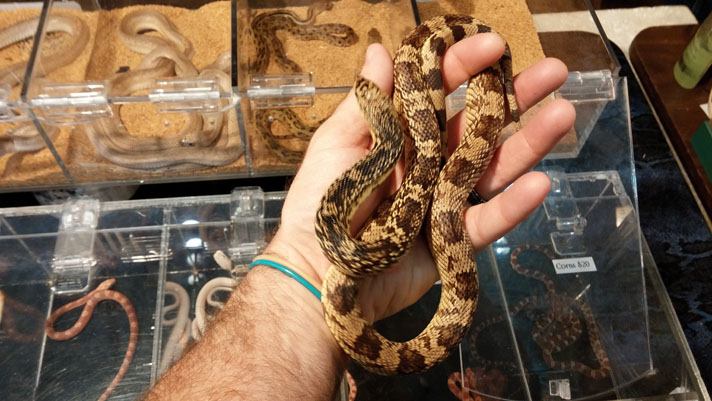
leo spinner
A Louisiana pine snake found at an expo.
All of the pine snakes are kept and bred in captivity, with the northern and black pine snakes being the most popular. Northern pines have a wonderful contrast of jet black and white along with shades of brown, pink and red. The large size and mild disposition of captive-born individuals make the northern pine snakes extremely attractive to potential buyers.
Often referred to as “the poor man’s indigo snake,” the black pine snake, with its high-gloss black scales, has etched its place into the hearts and collections of hobbyists, as well. Although it can sometimes be a little less tractable in captivity than the northern pine snake, the black pine snake is a fabulous, easily maintained captive and an amazing display animal. Like all of the pine snakes, black pines will reproduce readily in captivity, and captive-born babies will likely never go down in monetary value.
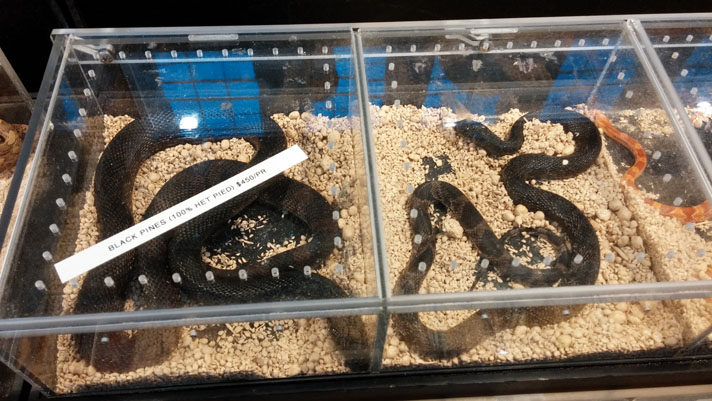
leo spinner
A black pine snake waiting to be sold at an expo.
The Florida pine snake, although just as full of character and vigor as the other subspecies of pine snakes, seems to hold less value to the average hobbyist, especially in its natural form. With its typically subdued shades of brown, tan and gray, the natural form of the Florida pine snake is not often seen on dealer’s lists, and while selectively bred specimens of albino and leucistic individuals often are available, they are still not demanding the higher prices of P. melanoleucus and P. lodingi.
Although quite manageable and captive breeding has been achieved on a regular basis, P. ruthveni remains the least commonly available, possibly due to its muted shades of yellow and brown coloration.
Pine Snake Care
As the evolution of herpetoculture presses ever forward, so has the husbandry techniques for the snakes we keep. With the growing demands of the pet trade, many breeders, it seems, have looked past the amazing beauty and scientific integrity of the natural wonders that make up this awe-inspiring field. Herps in the modern world, unfortunately, are often viewed primarily as a commodity, an up-and-coming project to improve on in an effort to get to the next level first while the market is still hot.
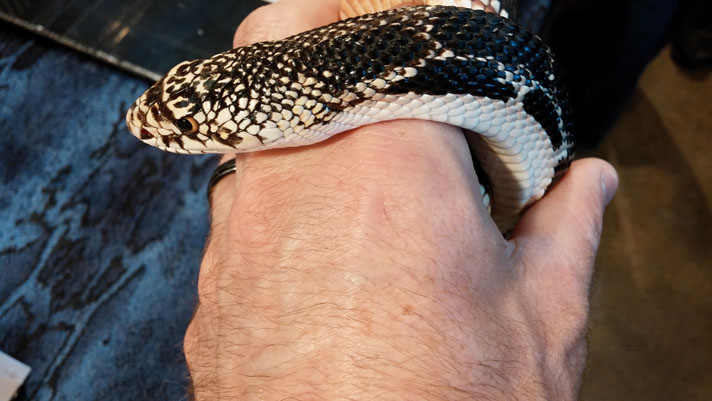
leo spinner
The author holds a northern pine snake at an expo.
However foreign it may be to my world, there is still something to be said for keeping your snakes in a rack system. When producing large numbers of snakes for a demanding market, maintaining them within a system of easily controlled micro-environments that provide convenience for the keeper and security for the snakes is logical. A single drawer in a rack system may consist of nothing more than a substrate of newspaper or natural bedding, such as aspen shavings, and a water bowl. If the drawer is translucent or opaque, then it may not even be necessary to include a hide box for the more sensitive species. The rack system works well where the conservation of space is necessary and when individual snakes need to be monitored for specific care. It seems that over the past few years, however, the rack system has become rather trendy among hobbyists and more people are keeping their snakes conveniently tucked away in these drawers rather than displaying their pets in an exposed, spacious, natural environment. Some keepers will keep one snake per drawer and introduce a second for breeding purposes when the season dictates. For adult pines, the drawers would likely be at least 73 quarts or 19 inches long, 13 inches wide and 15 inches tall.
To each his or her own, of course, but I prefer to watch my animals at any and all opportunities. To witness as much of their natural behavior as possible is why I keep herps in the first place. For those hobbyists who are able to display their pine snakes, it is always optimal to offer as much space as possible. Members of the genus Pituophis are very active and curious animals that seem to enjoy exploring their surroundings. Pairs of adult pine snakes can be housed in a 55- to 75-gallon tank in relative comfort, but a larger, custom-made environment would prove to be more rewarding to you and your snakes.
Your pine snakes enclosure may include a substrate of dried, ground bark mulch piled at least 3 inches deep to enable burrowing, or dust-free beach sand is another option. Some keepers prefer to keep their snakes on rubber-backed commercial carpet, which reduces the amount of work you may have during cleaning.
A few large, carefully placed stones, a firmly placed branch for climbing or basking, and a sturdy evenly shaped ceramic water bowl just large enough for drinking will complete the scene. Although water should be available at all times, it is important that the water container is not easily tipped. A damp environment for your pine snake in captivity equals skin infections and respiratory issues. Your pine snakes will assist you in keeping a clean environment by thoughtfully defecating right in the water bowl shortly after you place it in the enclosure. Be religious about keeping that water bowl clean in order to prevent potential health problems.
Keep the environment warm and dry. Ambient temperatures of 80 to 85 degrees Fahrenheit work well. Although a heat pad will likely not be used, an overhead light that throws off heat for basking will. A dome type lamp with a 100-watt bulb or heat emitter above one side of the enclosure will suffice for snakes of this genus. This will allow the snakes to thermal regulate—getting closer to the heat source would actually allow them to bring their body temperature up to 90 degrees if they choose to do so.
Full-spectrum lighting over your pine snake’s enclosure is not necessary but is highly recommended. The full-spectrum lighting will bring out the brilliant colors of your snake, and the snake will likely benefit psychologically, as well.
Want To Learn More?
Two Critically Endangered Louisiana Pine Snakes Hatched at Florida Zoo
A hide box large enough to encompass the entire snake, or even a section of PVC pipe, will be beneficial and used frequently by your snake. Keep in mind as much as 85 percent of a pine snake’s life may be spent underground.
Pine Snake Feeding
During the active periods of the year, your adult pine snakes can be fed twice a week, with one or two appropriately sized rodents or poultry. Pine snakes tend to have an insatiable appetite and metabolize quickly; they can easily be overfed or underfed. Pay close attention to the health of your snake. You should not be able to see the spinal column under the skin (as with those that are underweight) and the scales should over-lap evenly without visible skin between them (as with those that are overweight).
Pine Snake Captive Breeding
Captive breeding is easily achieved with this species if you stay within the standards of typical colubrid conditioning. With good body weight, adult pine snake will be ready for conditioning in late fall. Depending on the species, the snakes should be at adult size with good body weight before breeding. Most pine snakes will reach breeding size by 4 years old.
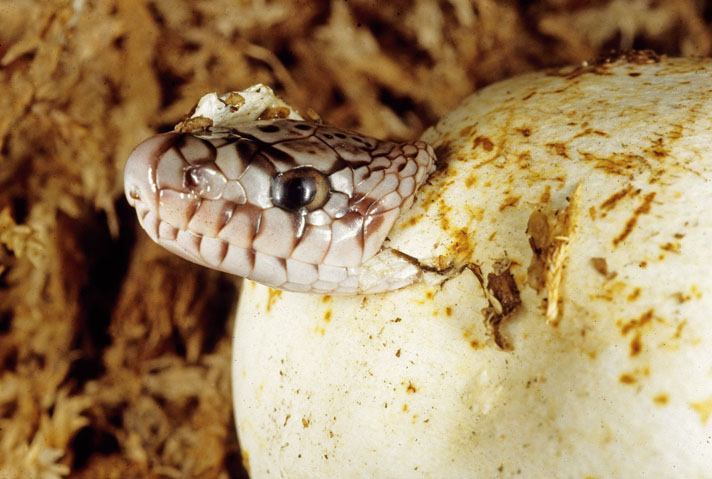
bill love
Pituophis melanoleucus melanoleucus hatching.
Begin conditioning by fasting your snake for two weeks at normal temperatures prior to winter cooling down. This fast will allow the snake time to empty its bowels completely before the winter rest. Reduce temperatures gradually down to 50 to 55 degrees, around the clock for approximately three months. After three months, gradually increase temperatures back to normal. It is at this time, if males and females had been cooled down separate, that they can be placed together. Mating should take place soon after the first post-brumation shed.
In approximately a month and a half after breeding, gravid females should be ready to deposit eggs. She will shed her skin about two weeks prior to oviposition. Around this time, a nesting box of dampened vermiculite can be placed in the enclosure. The box should be able to accommodate the full size of the gravid female snake and her eggs after deposition. Leave a cover on the enclosure with an opening large enough for your female pine snake to crawl through. She will usually lay as many as 20 or as few as three decent-sized eggs, that are roughly 11⁄2 by 21⁄2 inches (P. ruthveni lays a smaller clutch but larger eggs) in the box, but she will sometime surprise you and lay them in a random spot somewhere else in the enclosure. Remove eggs carefully, keeping in mind that they are adhered to one another and their surroundings. Eggs should be placed within the incubator in the same orientation that they were laid. Do not turn or jar the eggs, as such activity can prevent the eggs from developing. A pre-calibrated incubator set at 82 to 85 degrees will produce hatchlings in about 60 to 70 days.
Neonatal pine snakes are quite large, measuring 12 to 17 inches, and rather robust. Juvenile snakes will often eat right away and often before the first post-hatch shed. Rodent prey should be offered and specimens should not be fed items larger than the thickest part of their body. Care should be taken not to over feed neonates, as regurgitation is a frequent problem when over fed. Feed your snake, wait for it to digest and then feed again. Hatchling pine snakes can be maintained in the same manner as adults.
An American Mainstay
Over all, the pine snake will make an excellent, easily maintained captive, but pine snakes are not for everyone. These large animals have a serious appetite and require a lot of room to move around. They can be rather aggressive and extremely messy. Because of their captive-maintenance requirements, many pine snake keepers that I know of only keep pine snakes. It is also a good idea to propagate your own feeders when keeping more than one pine snake because of the amount of food that they are known to eat. If you are ready to meet the necessary requirements, then I am sure you will find that maintaining members of the genus Pituophis in captivity will be quite rewarding and an experience you won’t soon forget!
Leo Spinner is a native of Cape Cod in Massachusetts. He owns and operates Skin and Scales Live Animal Presentations and The Spotted Turtle Herpetological Institute of Cape Cod. He has been keeping and breeding all types of herps for more than 40 years.


